A look back in the ancient websites | The Internet & World Wide Web History
Is it to say any word about the Internet? Fairly, Not even in the third world’s interior part of African countries, as per Forbes recent article explained how a young woman in the sub-Saharan country using a smartphone to get into University. So the influence of the internet is everywhere and we are taking the benefits of this ‘tech miracle’ of the 21st century in our everyday life.

ad
As per internetadvisor.com As of now, there are about 1.8 billion websites with more than 4.2 billion active internet users but merely 200 million of those are really active websites. The milestone of 1 billion websites was first reached in September of 2014, as confirmed by NetCraft in its October 2014 Web Server Survey and first estimated and announced by Internet Live Stats (see the tweet from the inventor of the World Wide Web, Tim Berners-Lee – (The father of the internet).
So, above is the latest updated info and that is all under the reach of our knowledge. But, someone might have a curiosity (as I have had always) about how the websites look in the early days of its launch or let say what are the top websites of early days?
Let’s have a look at what, where and who were belonged to these questions in your mind. I collected all those detailed info and it took me days to dig out it by googled and streamlined to make it simple to understand. Let’s see how websites look in its early days.
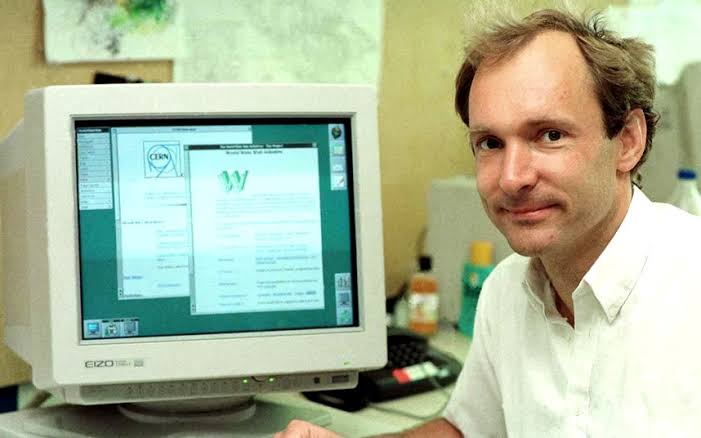
ad
World’s First 34 Website’s Homepages
1. CERN – 1991 (Switzerland)

The link is a snapshot of the CERN site <http://info.cern.ch>, the first website, as of November 1992. The Web was publicly announced (via a posting to the Usenet newsgroup alt.hypertext) on August 6, 1991, It was dedicated to information on the World Wide Web project and was made by Tim Berners-Lee. It ran on a NeXT computer at the European Organization for Nuclear Research Lab, CERN in Switzerland. The URL for the first-ever web page put up on the world’s first-ever website was http://info.cern.ch/hypertext/WWW/TheProject.html
Current status: Live under URL http://info.cern.ch
2. World Wide Web Virtual Library – 1991 (Switzerland)
Originally Tim Berners-Lee’s web catalog at CERN. The World Wide Web Virtual Library was the first index of content on the World Wide Web and still operates as a directory of e-texts and information sources on the web. It was started by Tim Berners-Lee creator of HTML and the World Wide Web itself, in 1991 at CERN in Geneva. Unlike commercial index sites, it is run by a loose confederation of volunteers, who compile pages of key links for particular areas in which they are experts. It is sometimes informally referred to as the “WWWVL”, the “Virtual Library” or just “the VL”.
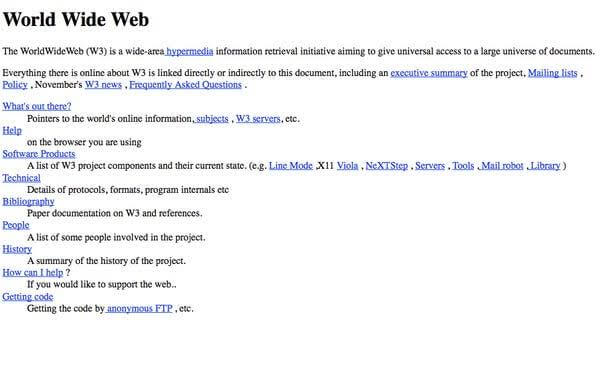
The individual indexes or virtual libraries live on hundreds of different servers around the world. A set of index pages linking these individual libraries is maintained at http://vlib.org/, in Geneva only a few kilometers from where the VL began life. A mirror of this index is kept at East Anglia (UK). A VL specific search engine has operated for some years and is now (VLsearch) located on its own server at vlsearch.org. To visit the early days look at this URL:
(While checking Wayback archives, the above webpage redirected to www.pharmacy.org page and stated the information here as under:
A Short History of Pharmacy.org (WWW Virtual Library: Pharmacy
Pharmacy.org is a database of pharmacy-related websites which was started around February-March 1994 (link no longer active) by David Bourne. In Feb 1994 there were about 1000 websites. The domain name www.cpb.uokhsc.edu later changed to www.cpb.ouhsc.edu with the change in a campus domain name. The database joined the WWW Virtual Library collection as the Pharmacy page. By early 1999 the website moved to www.pharmacy.org, it’s the current location. Entries are mainly added by request, manually.)
Current status: Live under URL http://vlib.org/
3. Stanford Linear Accelerator Center – 1991 (USA)
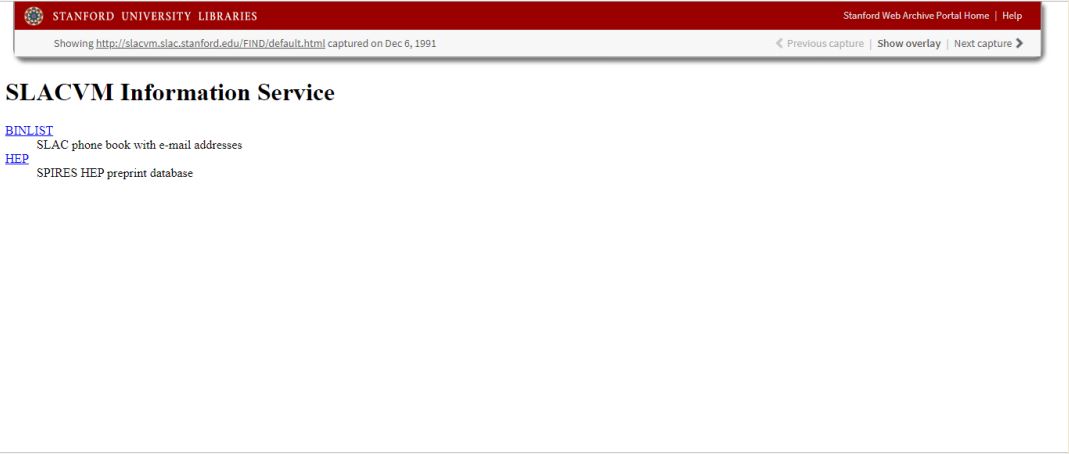
Paul Kunz from SLAC visited Tim Berners-Lee at CERN in September 1991. He was impressed by the WWW project and brought a copy of the software back to Stanford. SLAC launched the first web server in North America on December 12, 1991. The early look of the SLAC website made available by Stanford University Web Archive on the url: https://wayback.stanford.edu/19911206000000/http:/slacvm.slac.stanford.edu/FIND/default.html
Current status: Live under this URL www.slac.stanford.edu
4. Nikhef – 1992 (Netherlands)
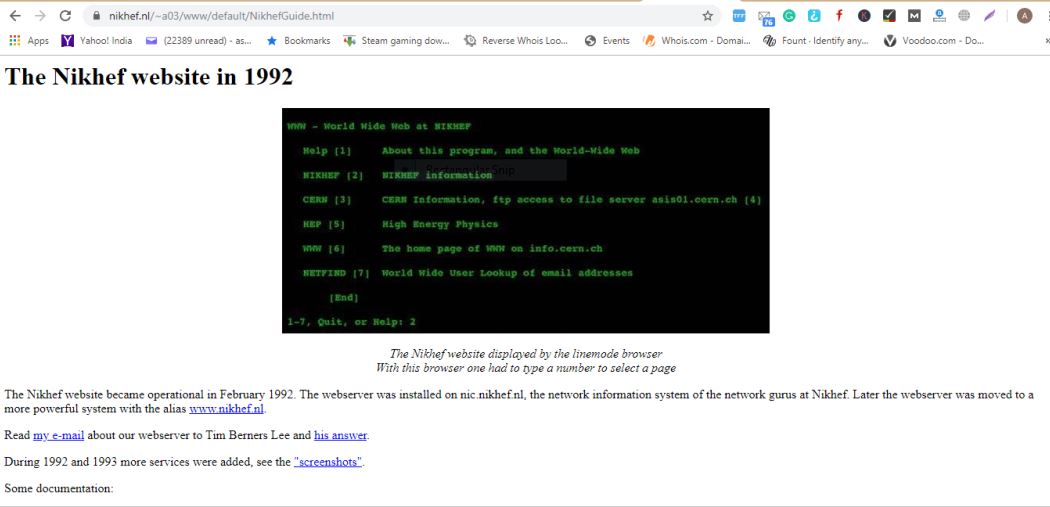
The Dutch National institute for subatomic physics, originally at http://nic.nikhef.nl. This site was actually the third website in the world to come online in February 1992, after CERN and SLAC. The web server was installed on nic.nikhef.nl, the network information system of the network gurus at Nikhef. Later the webserver was moved to a more powerful system with the alias www.nikhef.nl
The below URL showing the history of the world’s 3rd launched website ever before: https://www.nikhef.nl/~a03/www/default/NikhefGuide.html
The Nikhef website displayed by the linemode browser
With this browser, one had to type a number to select a page
Current status: Live under this URL https://www.nikhef.nl
5. National Center for Supercomputing Applications – 1992 (USA)
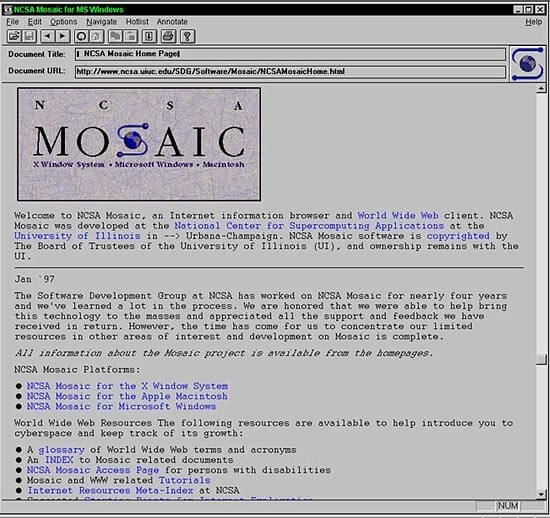
A team of students at the University of Illinois’ National Center for Supercomputing Applications, or NCSA, decided the web needed an experience more stimulating and user-friendly than that, so they set to work to build a better browser. Borrowing design and user interface cues from some other early prototype browsers, they went through a handful of iterations before arriving at the final 1.0 release on April 22, 1993.
The National Center for Supercomputing Applications site was an early home to the NCSA Mosaic web browser, as well as documentation on the web and a “What’s New?” list which many people used as an early web directory. The early days NCSA web looks like this on the URL here: http://www.ncsa.illinois.edu/enabling/mosaic
Current status: Live under this URL http://www.ncsa.illinois.edu
6. Fermilab – 1992 (USA)
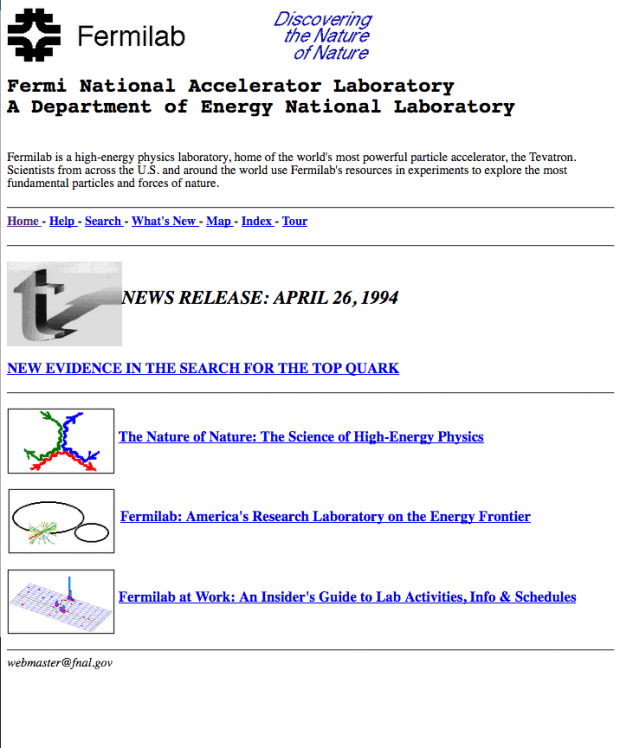
The 5th ever website was launched by Fermilab In June 1992 — one of the earliest websites in the United States.
In June 1992, Fermilab’s Computing Division installed its first web server. In late 1992, Computing Division staff created Fermilab’s first HTML page. Later, In February 1994, Fermilab created the laboratory’s first pages designed for the public.
In August 1996, the laboratory redesigned its growing volume of public webpages.
Current status: Live under URL http://www.fnal.gov/
7. SunSITE – 1992 (Austria)
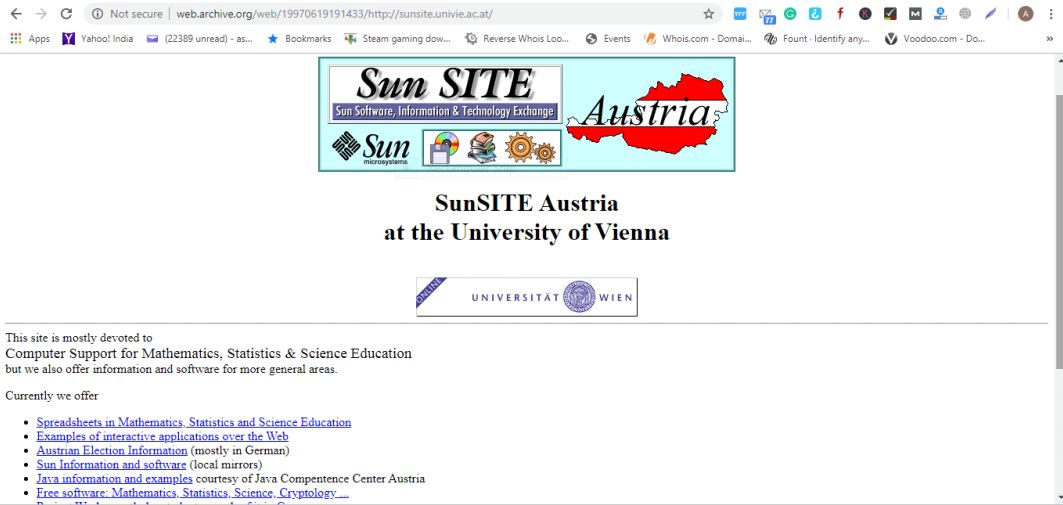
Early, the comprehensive archiving project started by the University of Vienna. The project as a whole started in 1992 and was quick to move to the web. It was just a piece of simple information about the University program and other information-centric with few links.
Current status: Live under this URL https://www.univie.ac.at/en/
8. Ohio State University Department of Computer and Information Science – 1992 (USA)
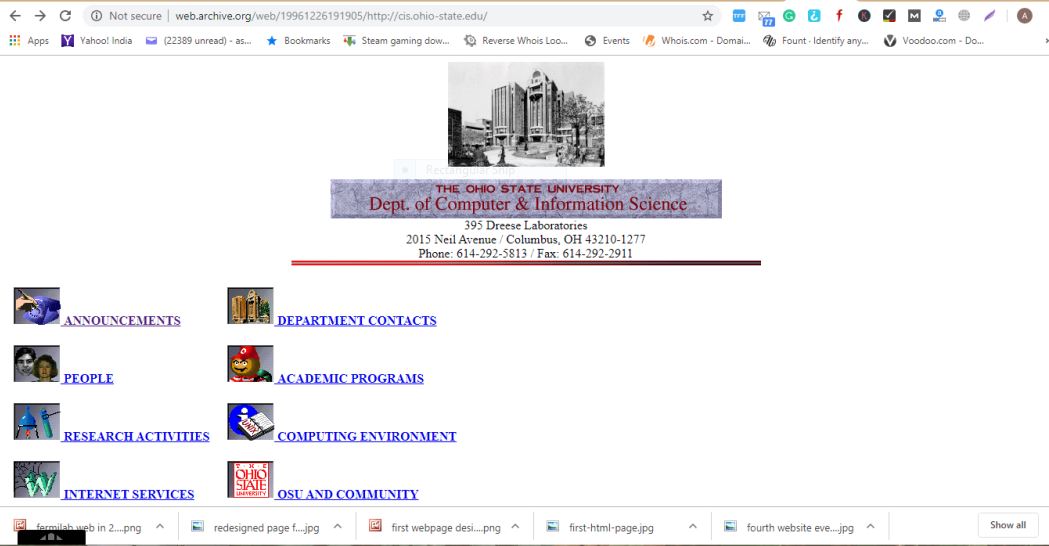
Early development of gateway programs, and the mass conversion of existing documents, including RFCs, Texinfo, UNIX man pages, and the Usenet FAQs. Their homepage showing the building of the Ohio State University and the complete address with contact info (email and website details missing in those days, having a fax No was ruling all over the world for high prestige for any organization) stated the simple info of the courses available in the University and with the people (faculty) and other research histories.
Current status: Live under this URL https://www.osu.edu/
9. IN2P3 – 1992 (France)
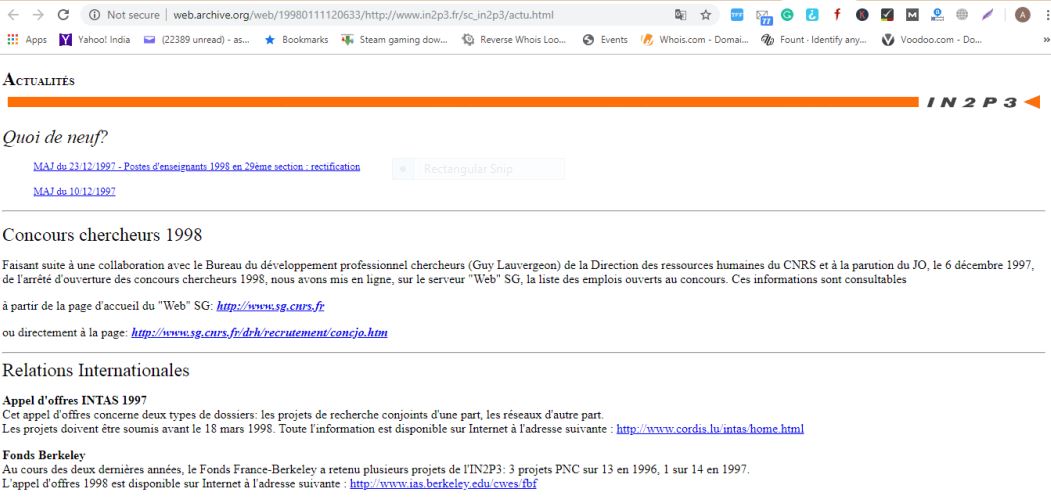
In the year 1992, The French National Institute for nuclear physics and particle physics launched their website. The early days’ french Govt owned website showing the elevation of its research institute building with the address and contact info.
Current status: Live under this URL http://info.in2p3.fr
10. HUJI – 1992 (Israel)
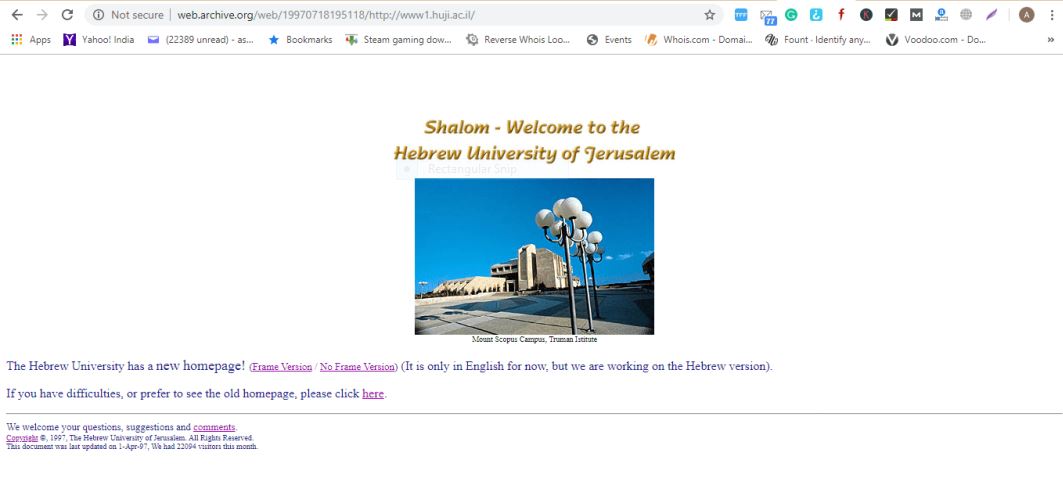
The Hebrew University of Jerusalem Information service – both in Hebrew and English. Was the first RTL website and the 10th to come online in April 1992.
Current status: Live under this URL http://www1.huji.ac.il/
11. Aliweb – 1993 (USA)
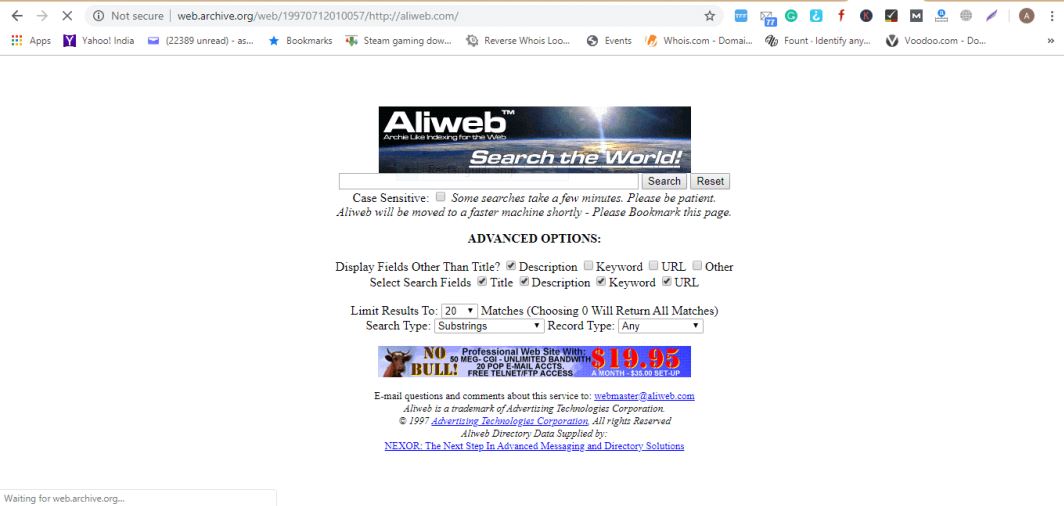
Aliweb (Archie Like Indexing for the Web) is considered the world’s first Web search engine, announced in October 1993 by developer Martijn Koster presented in May 1994 at the First International Conference at CERN in Geneva.
ALIWEB allowed users to submit the locations of index files on their sites which enabled the search engine to include webpages and add user-written page descriptions and keywords. This empowered webmasters to define the terms that would lead users to their pages, and also avoided setting bots (e.g. the Wanderer, JumpStation) which used up bandwidth. The downside of ALIWEB is that many people did not know how to submit their site. As relatively few people submitted their sites, ALIWEB was not very widely used.
Current status: defunct
{Note: The first few hundred web sites began in 1993 and most of them were at colleges, but long before most of them existed came Archie. The first search engine created was Archie, debuted on 10 September 1990 by Alan Emtage, a student at McGill University in Montreal. The original intent of the name was “archives,” but it was shortened to Archie.
Archie helped solve this data scatter problem by combining a script-based data gatherer with a regular expression matcher for retrieving file names matching a user query. Essentially Archie became a database of web filenames which it would match with the user’s queries.)
In the summer of 1993, no search engine existed for the web for few months.
12. Bloomberg – 1993 (USA)
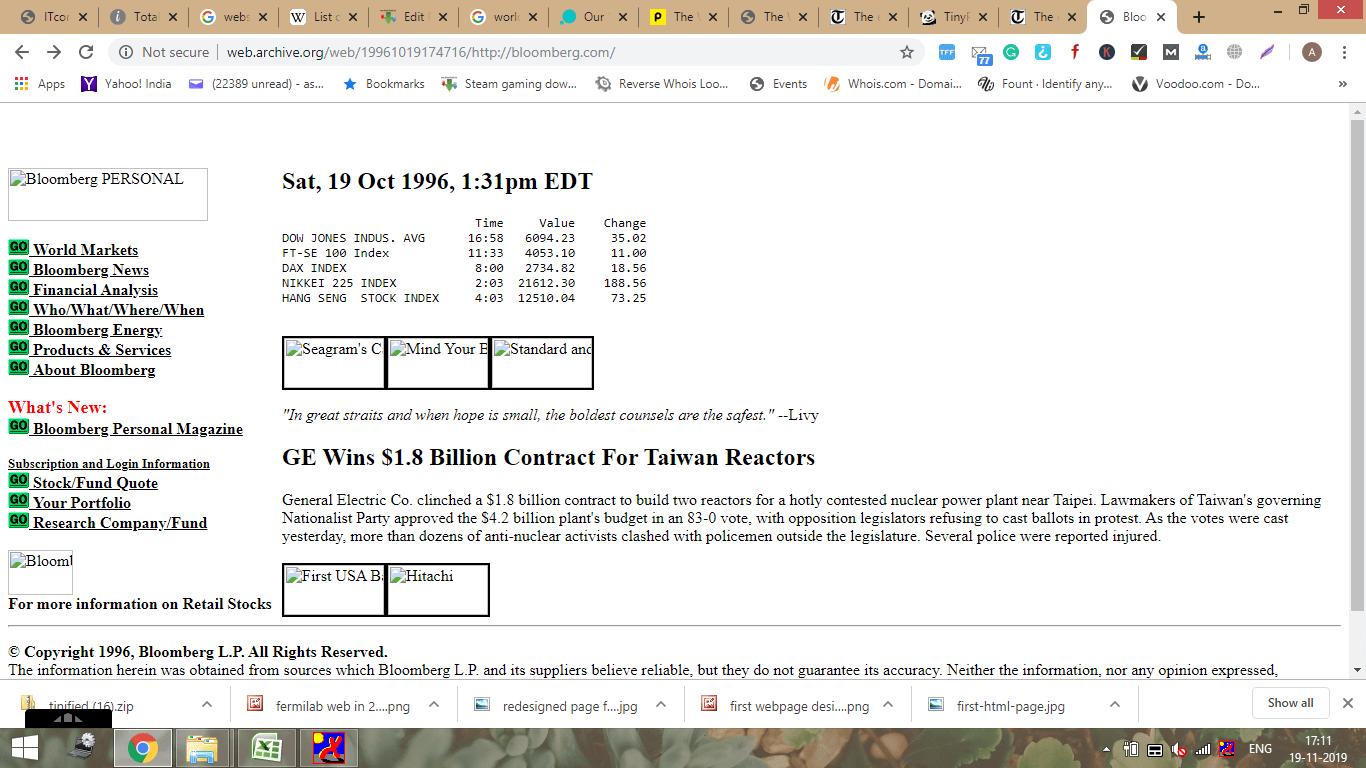
Bloomberg launched its news services division in 1990. Bloomberg.com was first established on September 29, 1993, as a financial portal with information on markets, currency conversion, news and events, and Bloomberg Terminal subscriptions Currently ranked among the top 10 financial news portals in the USA.
Current status: Live under this URL https://bloomberg.com
13. Chabad.org – 1993 (Israel)
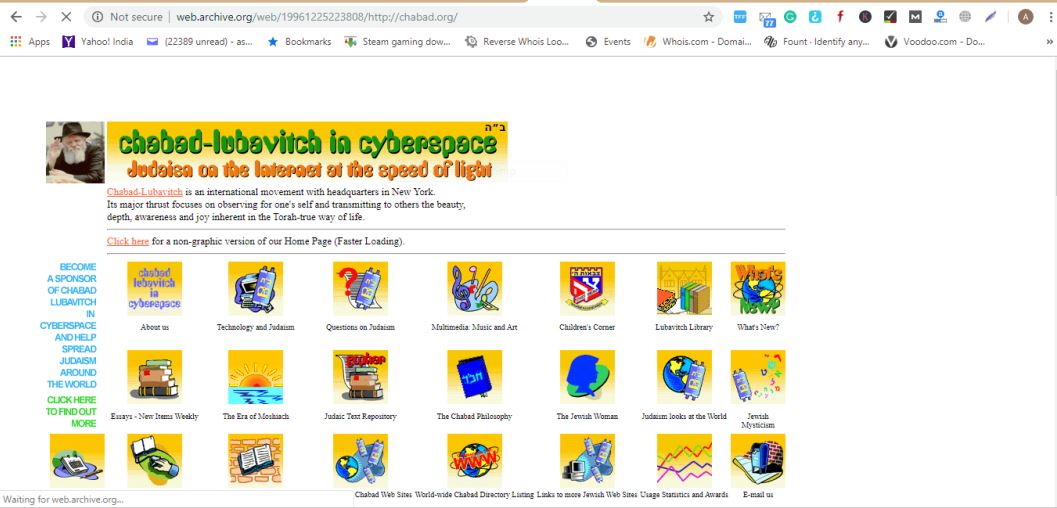
The flagship website of the Chabad-Lubavitch Hasidic movement. It serves its own members and Jews worldwide. It was one of the first Jewish internet sites and the first and largest virtual congregation. It was one of the first Jewish internet sites and the first and largest virtual congregation.
Current status: Live under this URL https://www.chabad.org/
14. Corpus of Electronic Texts – 1993 (formerly CURIA, IRELAND)
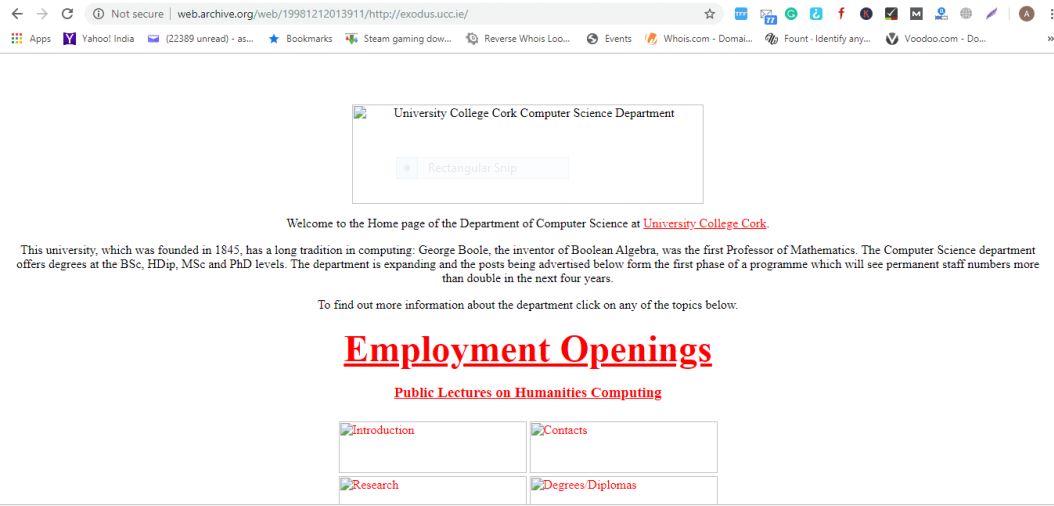
The Corpus of Electronic Texts, or CELT, is an online database of contemporary and historical documents relating to Irish history and culture. As of 8 December 2016, CELT contained 1,601 documents, with a total of over 18 million words. In 1992, CELT originated from the ashes of an unsuccessful partnership between University College Cork (UCC/NUI) and the Royal Irish Academy (RIA) through a project named CURIA. According to CELT, the database “caters for academic scholars, teachers, students, and the general public, all over the world”
Current status: Live under this URL https://celt.ucc.ie/ and the University web is live on https://www.ucc.ie/en/
15. Doctor Fun – 1993 (USA)
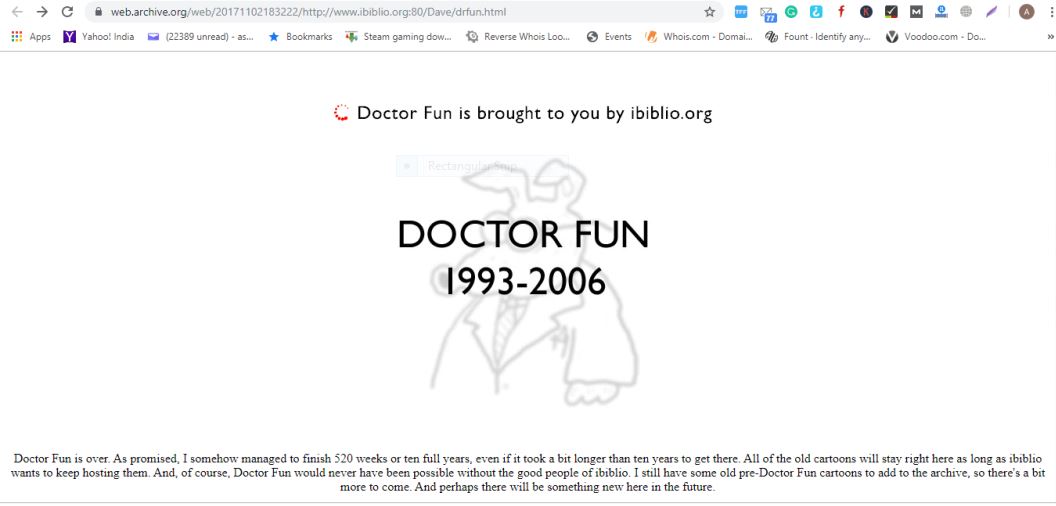
One of the first webcomics, noted by the NCSA as “a major breakthrough for the Web”. Doctor Fun was a webcomic by David Farley, which ran from September 24, 1993 to June 9, 2006. It may have been the first popular episodic World Wide Web comic strip. Doctor Fun was part of United Media’s website from 1995 until 2003, and it eventually concluded in 2006. The webcomic is often compared to the Far Side, being a series of one-panel gags.
Doctor Fun may have been the first popular episodic World Wide Webcomic.
It was preceded by Witches and Stitches which was distributed via CompuServe in 1985, and Where the Buffalo Roam which was distributed via Usenet in 1991. Dr. Fun’s appearance on the World Wide Web was noted by the NCSA, creator of the Mosaic web browser, as “a major breakthrough for the Web” in 1993. Farley started uploading Doctor Fun while working as a computer technician for the library system at the University of Chicago. At the time, Farley would do the pages of his webcomic “in batches”, though it took about an evening to finish each color cartoon.In 1995, Doctor Fun became part of United Media’s website. By 2003, Farley’s contract with United Media had “fallen through.”
In 2005, 128 pages of Doctor Fun were published by Plan Nine Publishing in the form of a full-color comic book. Farley stated this year that he hoped to keep doing Doctor Fun for at least ten years in total, or 520 weeks. On June 9, 2006, after posting the final page of his 520th week, he announced that his series was concluded.
Current status: defunct
16. The Exploratorium – 1993 (USA)
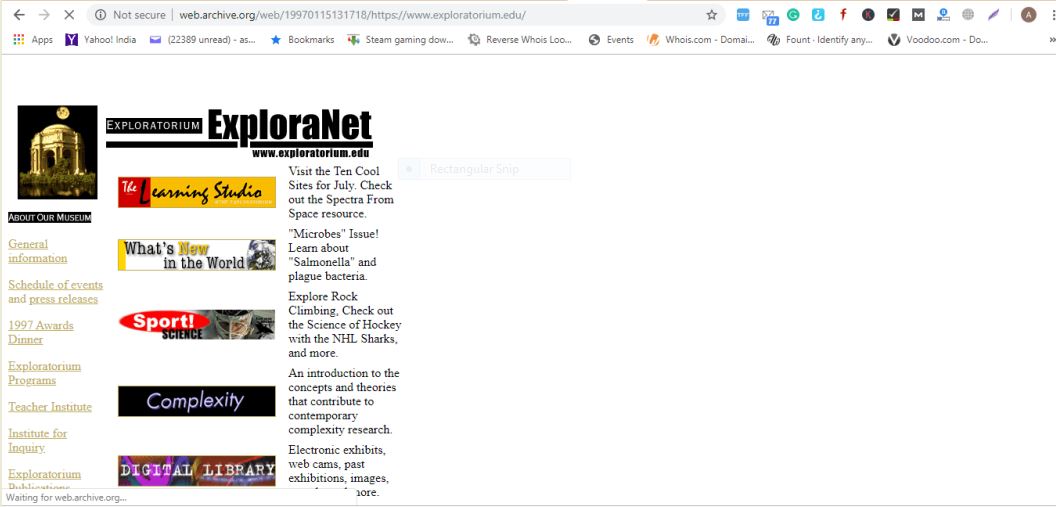
Online since 1993, the Exploratorium was one of the first museums to build a site on the World Wide Web. The site serves 13 million visitors each year. It has received six Webby Awards since 1997, including four for Best Science Website and one for Best Education website, and has been an honoree an additional ten times.
The Exploratorium’s website is an extension of the experiences on the museum’s floor and provides a large number of hands-on activities and exhibits for online-only visitors. The Exploratorium also broadcasts live video and/or audio directly from the museum floor (or from satellite feeds in the field, at such locations as Antarctica or the Belize rainforest) onto the Internet from its Webcast Studio. Webcasts provide access to special events, scientists, and other museum resources for audiences on the Web. Visitors to the website can hear or view interviews with scientists, “meet” interesting people, or tour unique locations from factories to particle accelerators.
Current status: Live under this URL https://www.exploratorium.edu/
17. The LANL preprint archive – 1993 (USA)
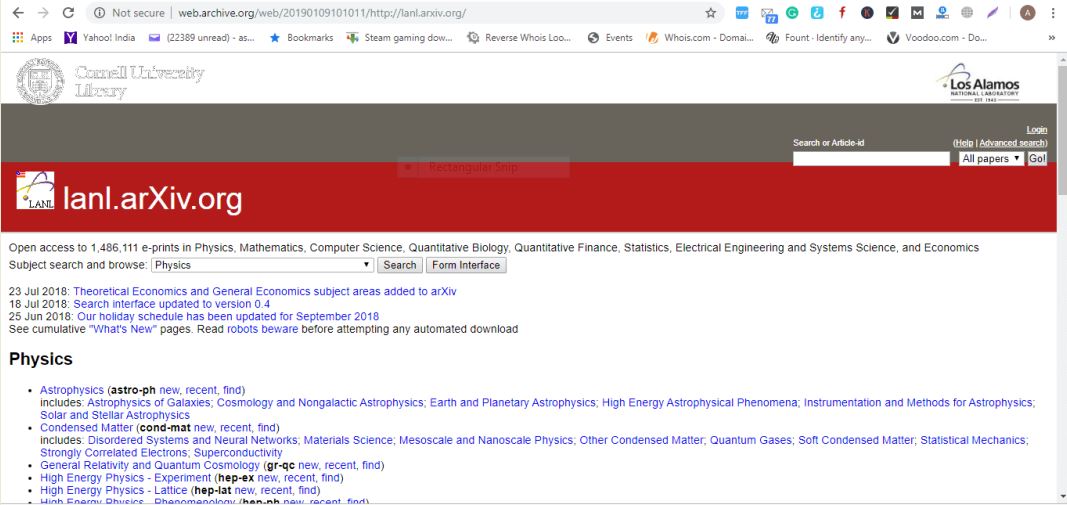
Web access to thousands of papers in physics, mathematics, computer science, and biology; developed out of earlier gopher, ftp, and e-mail archives at Los Alamos.
arXiv was made possible by the compact TeX file format, which allowed scientific papers to be easily transmitted over the Internet and rendered client-side. Around 1990, Joanne Cohn began emailing physics preprints to colleagues as TeX files, but the number of papers being sent soon filled mailboxes to capacity. Paul Ginsparg recognized the need for central storage, and in August 1991 he created a central repository mailbox stored at the Los Alamos National Laboratory (LANL) which could be accessed from any computer. Additional modes of access were soon added: FTP in 1991, Gopher in 1992, and the World Wide Web in 1993. The term e-print was quickly adopted to describe the articles.
It began as a physics archive, called the LANL preprint archive, but soon expanded to include astronomy, mathematics, computer science, quantitative biology and, most recently, statistics. Its original domain name was xxx.lanl.gov. Due to LANL’s lack of interest in the rapidly expanding technology, in 2001 Ginsparg changed institutions to Cornell University and changed the name of the repository to arXiv.org. It is now hosted principally by Cornell, with eight mirrors around the world.
Current status: Live under this URL https://arxiv.org/
18. Global Network Navigator – 1993 (USA)
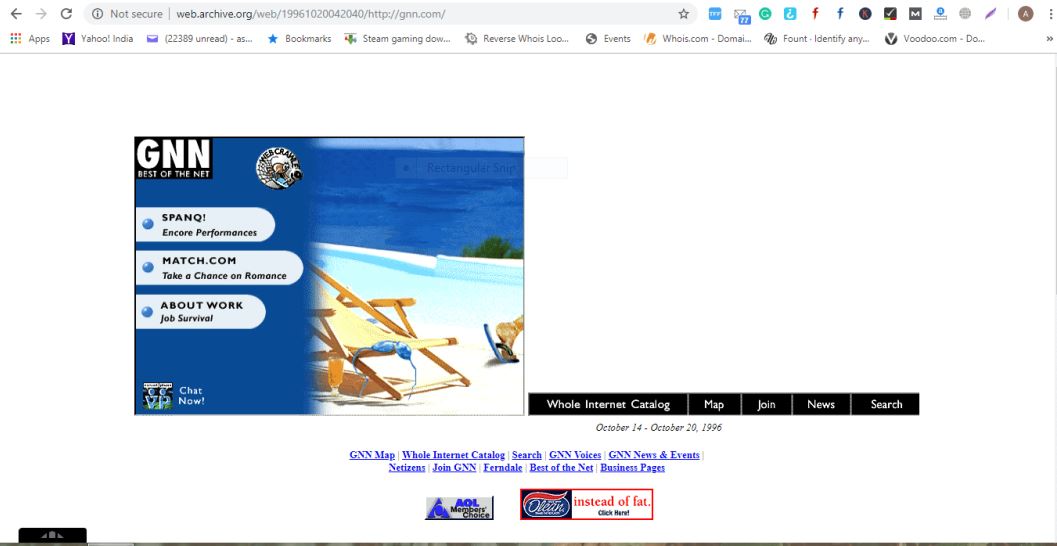
Example of an early web directory created by O’Reilly Media and one of the Web’s first commercial sites; it was hosted at Bolt Beranek and Newman (BBN).
The Global Network Navigator (GNN) was the first commercial web publication and the first web site to offer clickable advertisements. GNN was launched in May 1993, as a project of the technical publishing company O’Reilly Media, then known as O’Reilly & Associates.
In September 1992, O’Reilly & Associates published the Whole Internet User’s Guide and Catalog. The company then created an online version using ViolaWWW, a web browser that introduced enhanced HTML features such as formatting, graphics, scripting, and embedded applets and demonstrated a kiosk version that was deployed briefly at the Computer Literacy Bookshop in late 1992.
In February 1993, the company’s CEO, Tim O’Reilly, authorized a four-person “skunkworks” team, led by Dale Dougherty, and began planning for what would become GNN. The website was officially launched in August 1993 at Interop in San Francisco. A press release described GNN as..
“… a free Internet-based information center that will initially be available as a quarterly. GNN will consist of a regular news service, an online magazine, The Whole Internet Interactive Catalog, and a global marketplace containing information about products and services”
In June 1995, GNN was sold to AOL, which continued its editorial functions while converting it to a dial-up Internet Service Provider. AOL closed GNN in December 1996, moving all GNN subscribers to the AOL dial-up service.
Current status: defunct
19. Haystack Observatory – 1993 (USA)
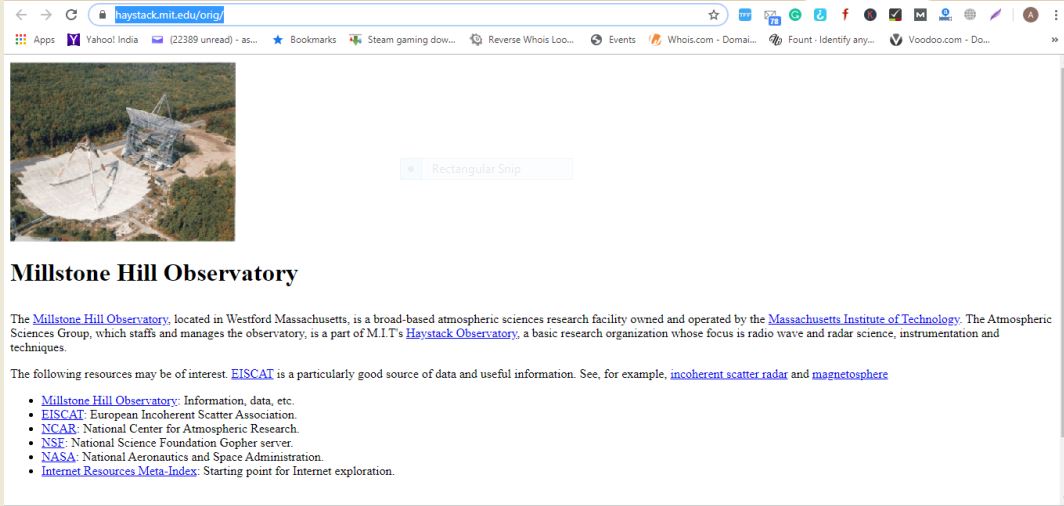
Haystack Observatory’s web site explained its radio and radar remote sensing mission and provided data access for science users. The content was rolled out on December 13, 1993, by Dr. John Holt of Haystack. The web site is still active, and the original web page format is still available online. https://www.haystack.mit.edu/orig/
Current status: Live under this URL https://www.haystack.mit.edu/
20. The Internet Movie Database (IMDB) – 1993 (England)
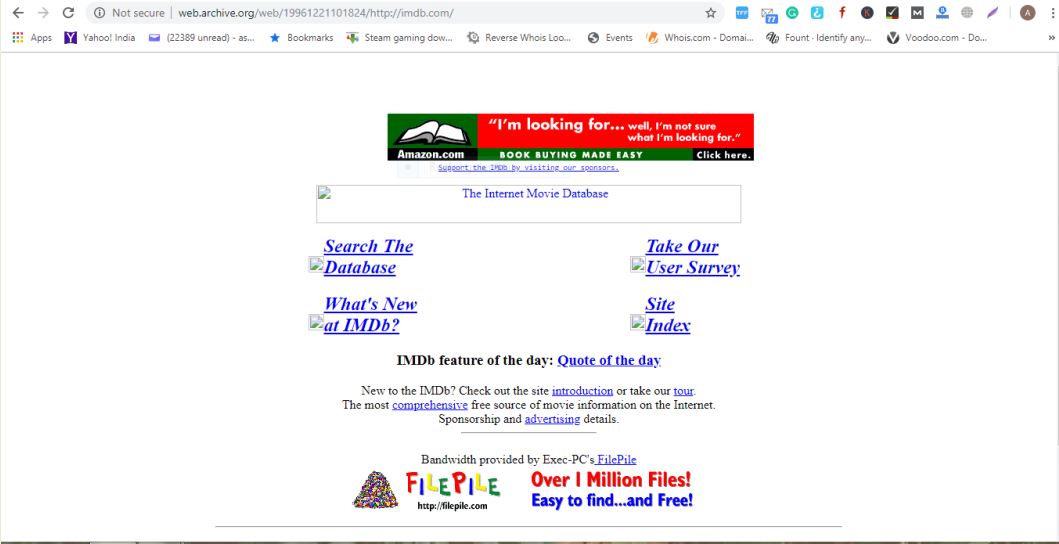
Founded in 1989 by participants in the Usenet newsgroup rec.arts.movies, the IMDB was rolled out on the web in late 1993, hosted by the computer science department of Cardiff University in Wales.
The database had been expanded to include additional categories of filmmakers and other demographic material as well as trivia, biographies, and plot summaries. The movie ratings had been properly integrated with the list data, and a centralized email interface for querying the database had been created by Alan Jay. Later, in 1993, it moved onto the fledgling World Wide Web under the name of Cardiff Internet Movie Database.
The database resided on the servers of the computer science department of Cardiff University in Wales. Rob Hartill was the original web interface author. In 1994, the email interface was revised to accept the submission of all information, which enabled people to email the specific list maintainer with their updates. However, the structure remained so that information received on a single film was divided among multiple section managers, the sections being defined and determined by categories of film personnel and the individual filmographies contained therein. Over the next few years, the database was run on a network of mirrors across the world with donated bandwidth.
In 1996 IMDb was incorporated in the United Kingdom, becoming the Internet Movie Database Ltd. Founder Col. Needham became the primary owner as well as the figurehead. General revenue for site operations was generated through advertising, licensing and partnerships
In 1998, Jeff Bezos, founder, owner, and CEO of Amazon.com struck a deal with Needham and other principal shareholders to buy IMDb outright for approximately $55 million and attach it to Amazon as a subsidiary, private company.
Current status: Live under this URL www.imdb.com
21. Internet Underground Music Archive
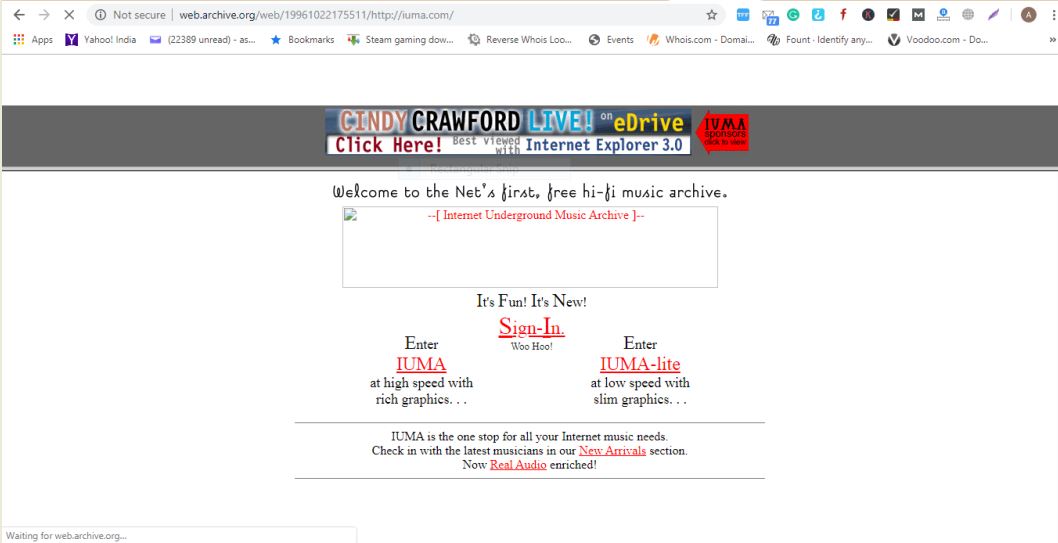
Created by students at the University of California, Santa Cruz to help promote unsigned musical artists. Music was shared using the MP2 format, presaging the later extreme popularity of MP3 sharing and Online music stores.
IUMA is widely recognized as the birthplace of on-line music. IUMA’s goal was to help independent artists use the Internet to distribute their music to fans while circumventing the usual distribution model of using a record company. IUMA was started by Rob Lord, Jeff Patterson and Jon Luini from the University of California, Santa Cruz in 1993.
IUMA originally existed as FTP and Gopher sites, before the World Wide Web was widely used. On March 9, 1994, CNN featured IUMA in its “Showbiz News” segment. In June 1999, IUMA was purchased by EMusic and moved operations from Santa Cruz to Redwood City, home of the EMusic offices. IUMA provided artists who registered with a free URL and web page. The artists could present their music over the Internet in a stream, download, and internet radio format. Further, it provided an easy-to-use home page for the band and the ability to distribute their music with no bandwidth fees. Some of the original file formats used to encode the music were WAV, AIFF, and MP2. MP3 was added later as that format became more popular.
In 2000, IUMA offered US$5,000 to couples who named their baby “Iuma”. Several families took up the offer. IUMA flourished, hosting events such as “Music-o-mania”, the largest online “Battle of the Bands” ever held.
In late May 2012, Jason Scott Sadofsky (founder of Textfiles.com) announced that much of IUMA’s collection has been reposted via the Internet Archive. John Gilmore, the co-founder of the Electronic Frontier Foundation (EFF), managed to retrieve the surviving files before its shutdown.
Current status: defunct
22. JumpStation – 1993 (England)
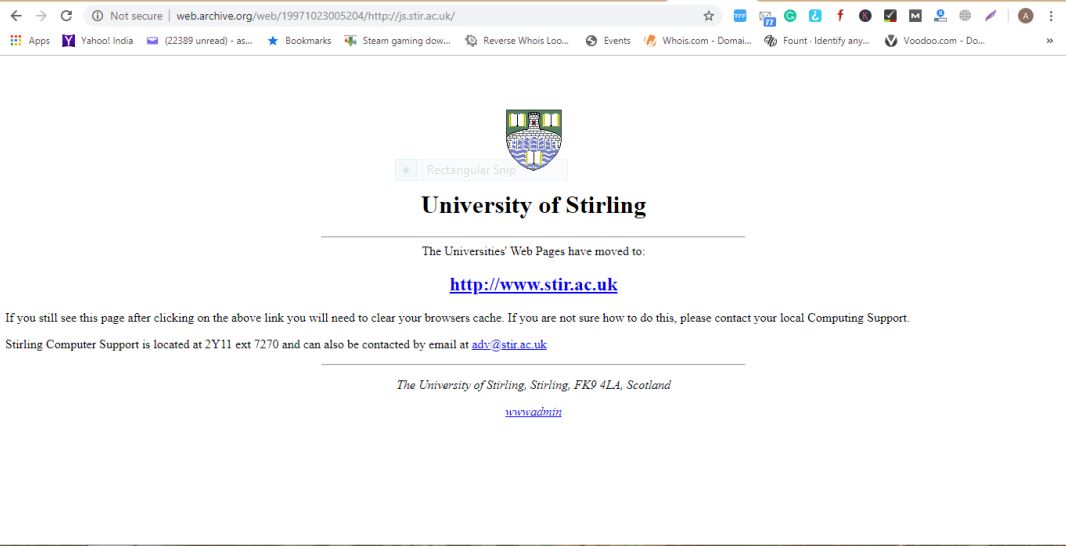
JumpStation was the first WWW search engine created by Jonathon Fletcher on December 12, 1993, and hosted at the University of Stirling in Scotland. In operation until 1994. The first internet search engine that behaved, and appeared to the user, the way current web search engines do. It started indexing on 12 December 1993 and was announced on the Mosaic “What’s New” webpage on 21 December 1993. It was hosted at the University of Stirling in Scotland.
It was written by Jonathon Fletcher, from Scarborough, England, who graduated from the University with a first-class honours degree in Computing Science in the summer of 1992 and has subsequently been named “father of the search engine”.
He was subsequently employed there as a systems administrator. JumpStation’s development discontinued when he left the University in late 1994, having failed to get any investors, including the University of Stirling, to financially back his idea. At this point, the database had 275,000 entries spanning 1,500 servers.
JumpStation used document titles and headings to index the web pages found using a simple linear search and did not provide any ranking of results. However, JumpStation had the same basic shape as Google search in that it used an index solely built by a web robot, searched this index using keyword queries entered by the user on a web form whose location was well-known and presented its results in the form of a list of URLs that matched those keywords.
Current status: defunct
23. Kent Anthropology

One of the first social science sites (online May 1993). Originally at http://lucy.kent.ac.uk/. Still online at
Michale Fischer was a professor of Anthropological Sciences at the University of Kent, Canterbury. Early he was engaged in music and computer businesses in Austin and Memphis, USA. Following is a doctorate at UT Austin, in 1985 he joined Kent University as a lecturer of Anthropology and Computing. Professor Fischer promotes the uses of computers in anthropological fieldwork at the Kent Uni.
He initiated his first interactive anthropology resource on the IPSS network, which was viewed by the Queen in 1988. So, students at Kent University occasionally referred professor Fischer as the only person at Kent who has met both the Queen and the King. In 1989, he became the Director of the Centre for Social Anthropology and Computing at Kent. In April 1993 he initiated the first anthropology website in May 1993 as one of the first 200 web servers on earth, before changing its name in January 1994 to become the Ethnographic Gallary. So, the first-ever social science website was launched from the Kent University campus in England.
Current status: Live under this URL http://csac.anthropology.ac.uk/bin/EthnoGraphics+Gallery While The University of Kent has a separate live website on http://lucy.kent.ac.uk/
24. SITO – 1993 (USA)
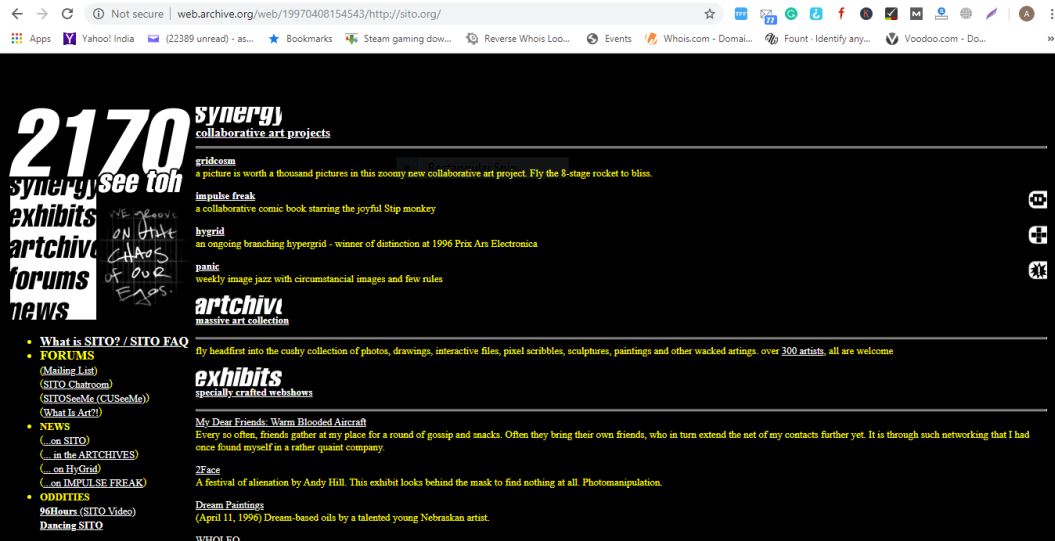
SITO is an online artist collective that began in January 1993, making it one of the oldest Internet-based art organizations. It was started by Ed Stastny and has been maintained by Stastny and a group of volunteers and supporters.
From its beginning, SITO had a mission different from many established Internet art resources, in that rather than be an electronic journal of discussions or writings about art, it chose to be a repository for artwork in order to facilitate sharing and exposure. As this was the Internet pre-World Wide Web, SITO accomplished this by using anonymous FTP sites. Another important part of the SITO mission was to be open to all levels of artists and at no cost. SITO was one of the earliest online galleries, and this showcase of artwork has become known as the Archive.
After a start as an anonymous ftp-based art gallery and collaborative collective, the OTIS project (later SITO) moved to the web, hosting supported by SunSITE.
Current status: Live under this URL www.sito.org
25. The Tech – 1993 (USA)
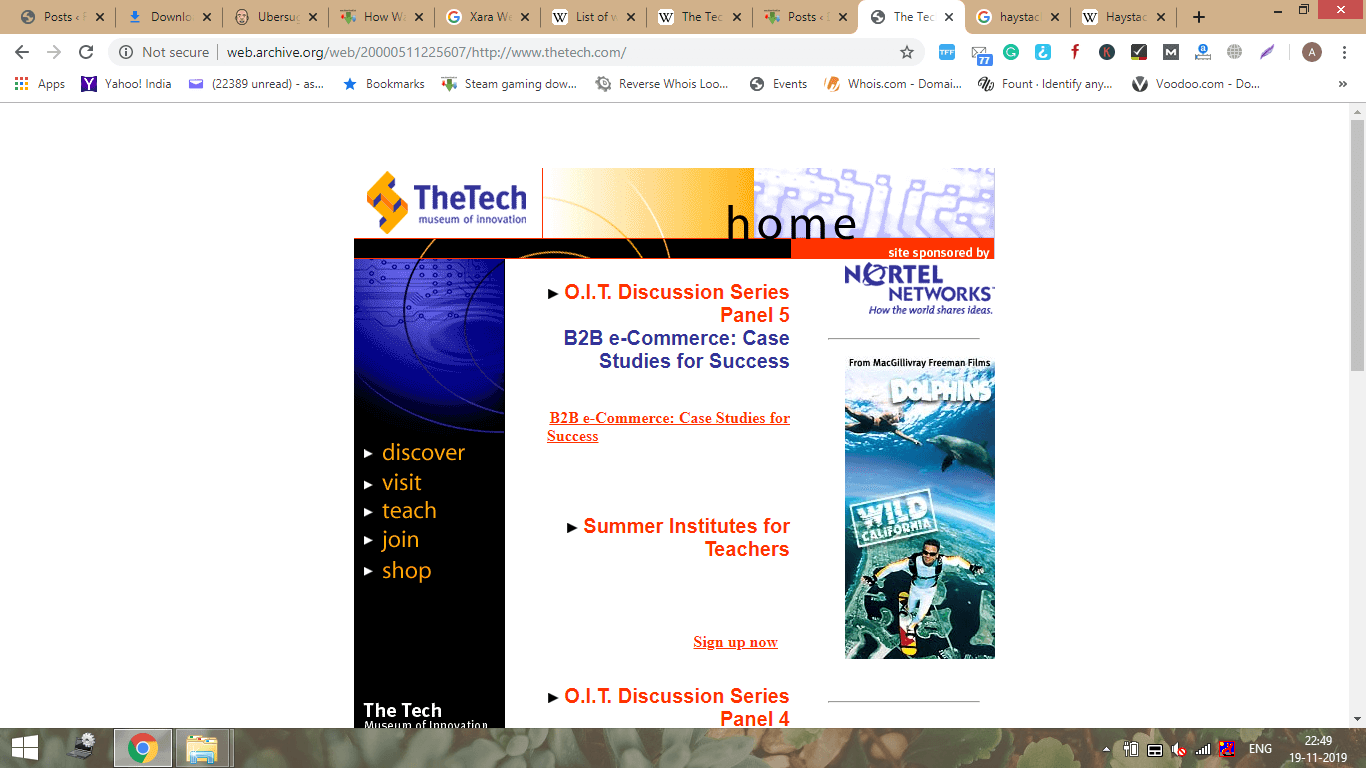
The Tech newspaper was an early publisher on the World Wide Web, first publishing online in 1993. Earlier, StarText, the Fort Worth Star-Telegram’s videotex system which displayed newspaper content on computer screens, began in 1982 in Fort Worth, Texas (but did not go on the Internet until 1996). In 1987, the Middlesex News (Framingham, Massachusetts) launched Fred the Computer, a single-line BBS system used to preview the next day’s edition and later to organize the newspaper’s past film reviews.
Nearly every published issue of The Tech is available online, and most issues are accessible as PDF files, including the first issue, edited by Arthur W. Walker, which was originally printed by Alfred Mudge & Son, Printers, located at 34 School Street in Boston.
Current status: Live under this URL https://thetech.com/
26. Nexor – 1993 (England)
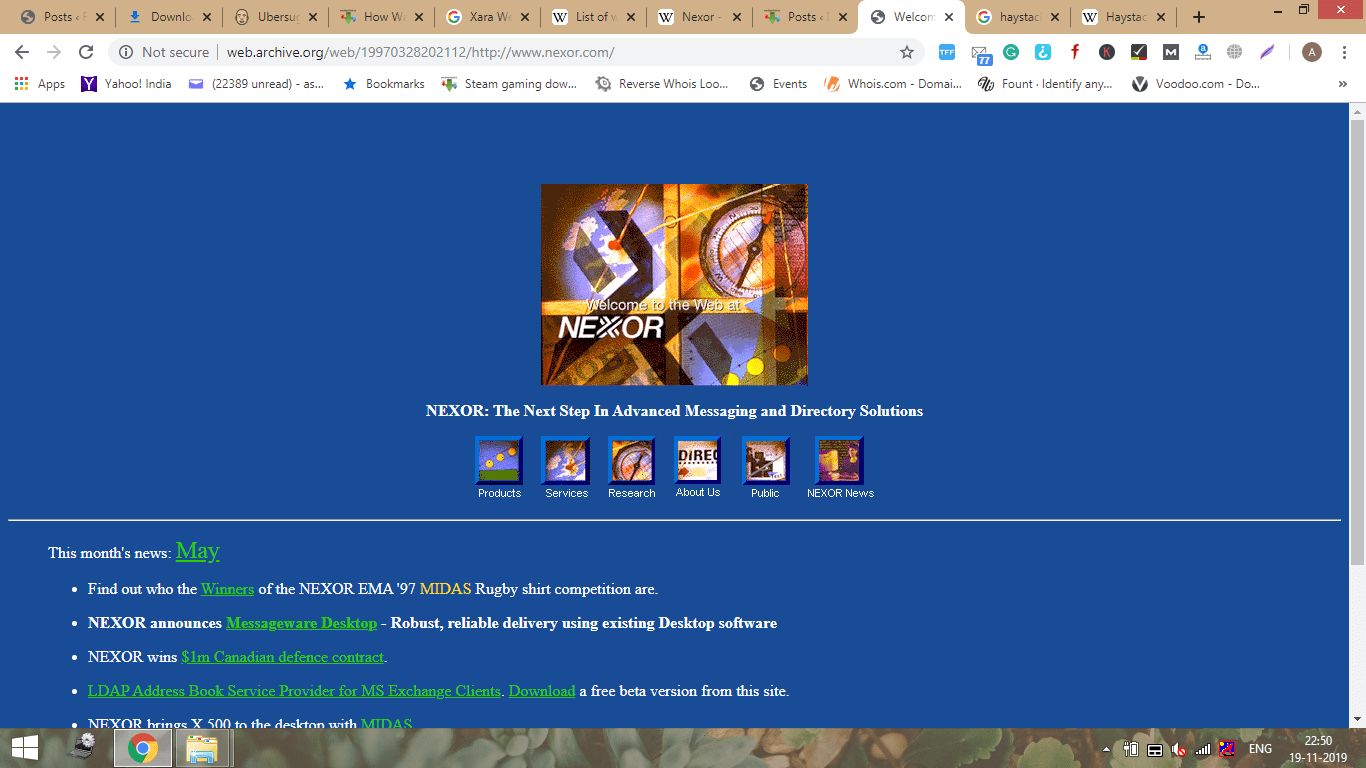
Web site set up for Nexor an early Internet software company, by Martijn Koster a Dutch software engineer noted for his pioneering work on Internet searching.,
Nexor Limited was founded in 1989 as X-Tel Services Limited out of the University of Nottingham and UCL, following research into X.400 and X.500 systems for the ISODE project. In 1992 Stephen Kingan joined the business as CEO. In 1993 X-Tel Services Limited was renamed Nexor Limited. In 1996 3i invested in the business to launch Nexor Inc. In 2004 Kingan and Nigel Fasey acquired the business. In 2008 Colin Robbins was appointed to the board as CTO. In 2012 Kingan acquired 100% ownership of Nexor. In October 2013, the company moved headquarters from Nottingham Science Park to the NG2 Business Park.
Nexor customers include NATO, European Defence Agency, UK MoD, US DOD, Canadian DND, Foreign, and Commonwealth Office and Met Office. Nexor designed and deployed the first public Internet search engine ALIWEB and the associated robots exclusion standard. Nexor is a contributor to the Internet Engineering Task Force, having worked on Internet RFCs 1086,1165,1488, 1606 and 1778. Nexor developed a Microsoft Exchange Client for Unix. Nexor was the first organization to be awarded the Intellect Best Practice Certificate.
Current status: Live under this URL www.nexor.com
27. MTV – 1993 (USA)

The music television network’s domain was registered in 1993 by VJ Adam Curry, who personally ran a small unofficial site.
In the late 1980s, before the World Wide Web, MTV VJ Adam Curry began experimenting on the Internet. He registered the then-unclaimed domain name “MTV.com” in 1993 with the idea of being MTV’s unofficial new voice on the Internet. Although this move was sanctioned by his supervisors at MTV Networks at the time, when Curry left to start his own web-portal design and hosting company, MTV subsequently sued him for the domain name, which led to an out-of-court settlement.
The service hosted at the domain name was originally branded “MTV Online” during MTV’s first few years of control over it in the mid-1990s. It served as a counterpart to the America Online portal for MTV content, which existed at AOL keyword MTV until approximately the end of the 1990s. After this time, the website became known as simply “MTV.com” and served as the Internet hub for all MTV and MTV News content.
Current status: Live under this URL www.mtv.com
28. PARC Map Server – 1993 (USA)
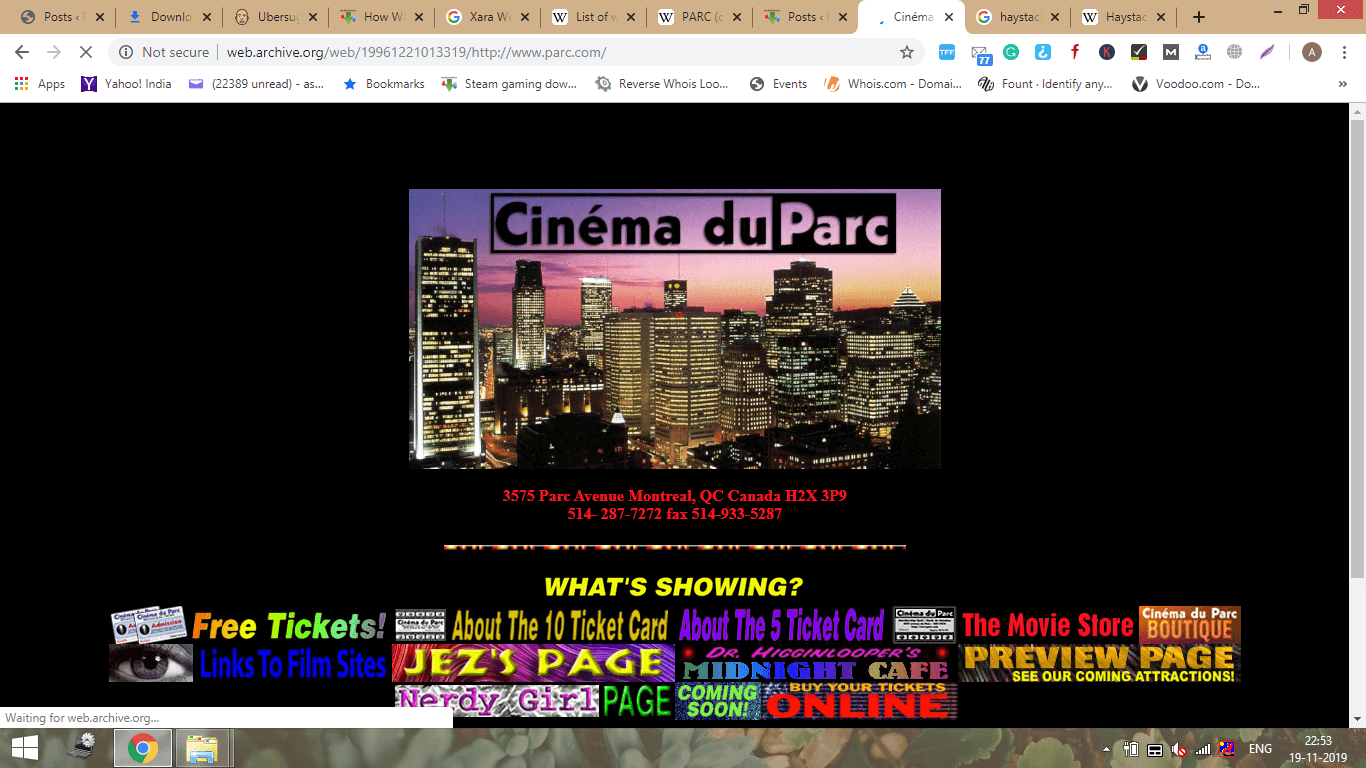
Arguably the earliest precursor of MapQuest and Google Maps. PARC Researcher Steve Putz tied an existing map viewing program to the web.
Xerox PARC Map Viewer was one of the earliest static web mapping sites, developed by Steve Putz in June 1993 at Xerox Corporation’s Palo Alto Research Center (PARC). The Xerox PARC Map Viewer was an experiment in providing interactive information retrieval, rather than access to just static files, on the World Wide Web.
Map Viewer used a customized CGI server module written in Perl. Map images were generated in GIF format from two server-side programs. MAP-WRITER created the raster images from the geographic database and RASTOGIF would convert the raster image into the GIF format.
Xerox has since discontinued the Map Viewer service.
Current status: defunct
29. photo.net – 1993 (USA)
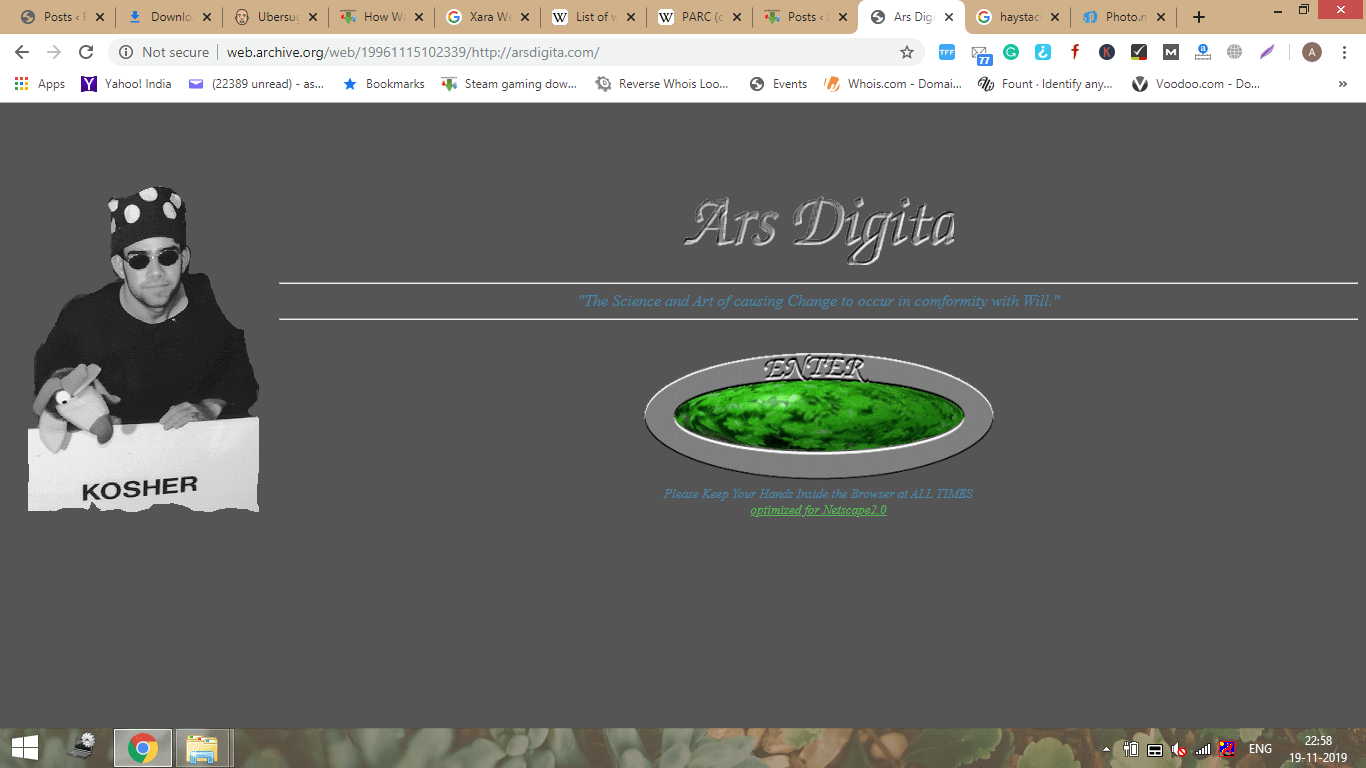
In 1993, Greenspun founded photo.net, an online community for people helping each other to improve their photographic skills. He seeded the community with “Travels with Samantha”, a photo-illustrated account of a trip from Boston to Alaska and back. Photo.net became a business in 2000 with the help of some of his cofounders Rajeev Surati and Waikit Lau. Having grown to 600,000 registered users was acquired by NameMedia in 2007 for $6 million, according to documents filed in connection with a planned public offering of NameMedia shares
An online photography resource and community, designed and founded by Greenspun. He released the software behind photo.net as a free open-source toolkit for building community websites, the ArsDigita Community System.
Started in 1993 and strive to be the best peer-to-peer educational system for people who wish to become better photographers, photo.net was acquired by NameMedia, Inc on October 17, 2007.
Current status: Live under this URL www.photo.net
30. Principia Cybernetica – 1993 (Belgium)
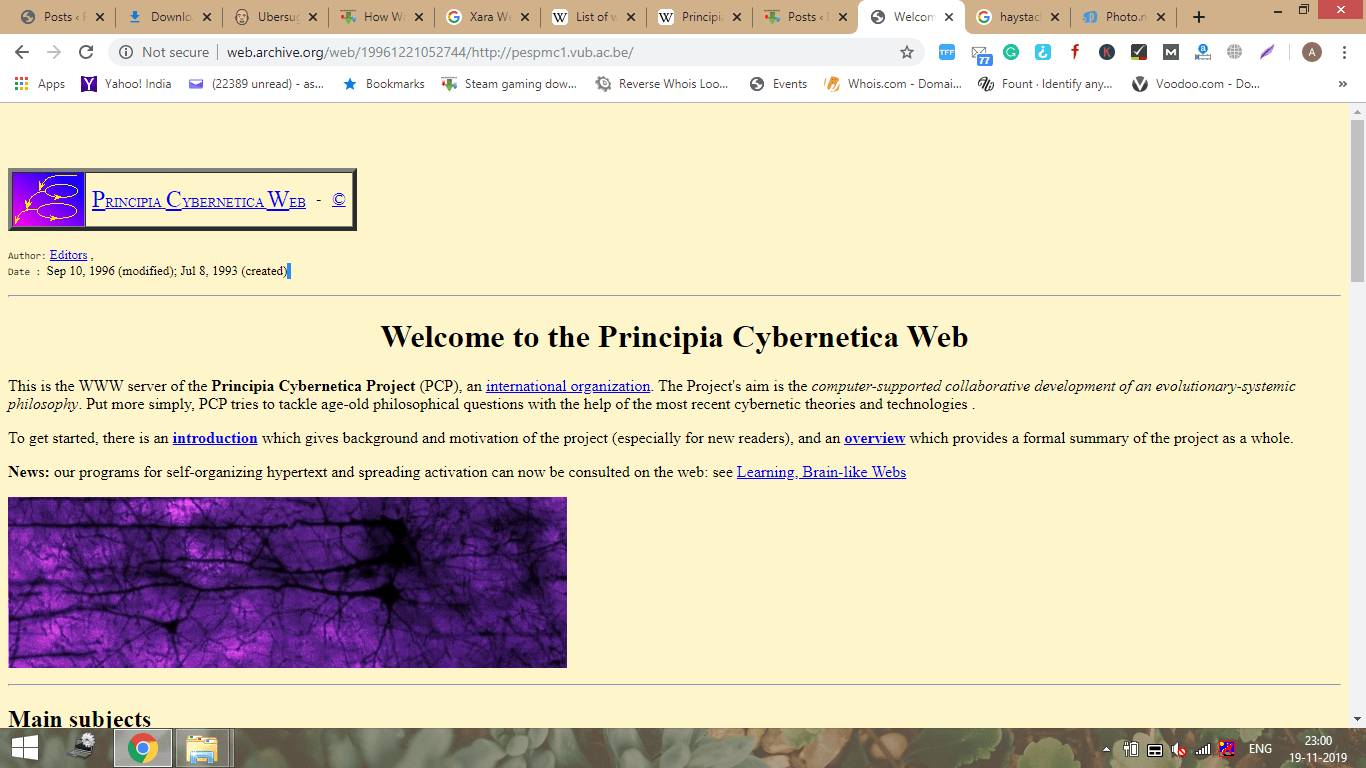
Probably the first complex, collaborative knowledge system, sporting a hierarchical structure, index, map, annotations, search, plenty of hyperlinks, etc. Designed by Francis Heylighen, Cliff Joslyn, and Valentin Turchin to develop a cybernetic philosophy.
Principia Cybernetica is an international cooperation of scientists in the field of cybernetics and systems science, especially known for its website, Principia Cybernetica. They have dedicated their organization to what they call “a computer-supported evolutionary-systemic philosophy, in the context of the transdisciplinary academic fields of Systems Science and Cybernetics”
The Principia Cybernetica Web, which went online in 1993, is one of the first complex webs in the world. It is still viewed as one of the most important sites on cybernetics, systems theory, complexity, and related approaches.
Current status: Live under this URL http://pespmc1.vub.ac.be/
31. ExPASy – 1993 (Switzerland)
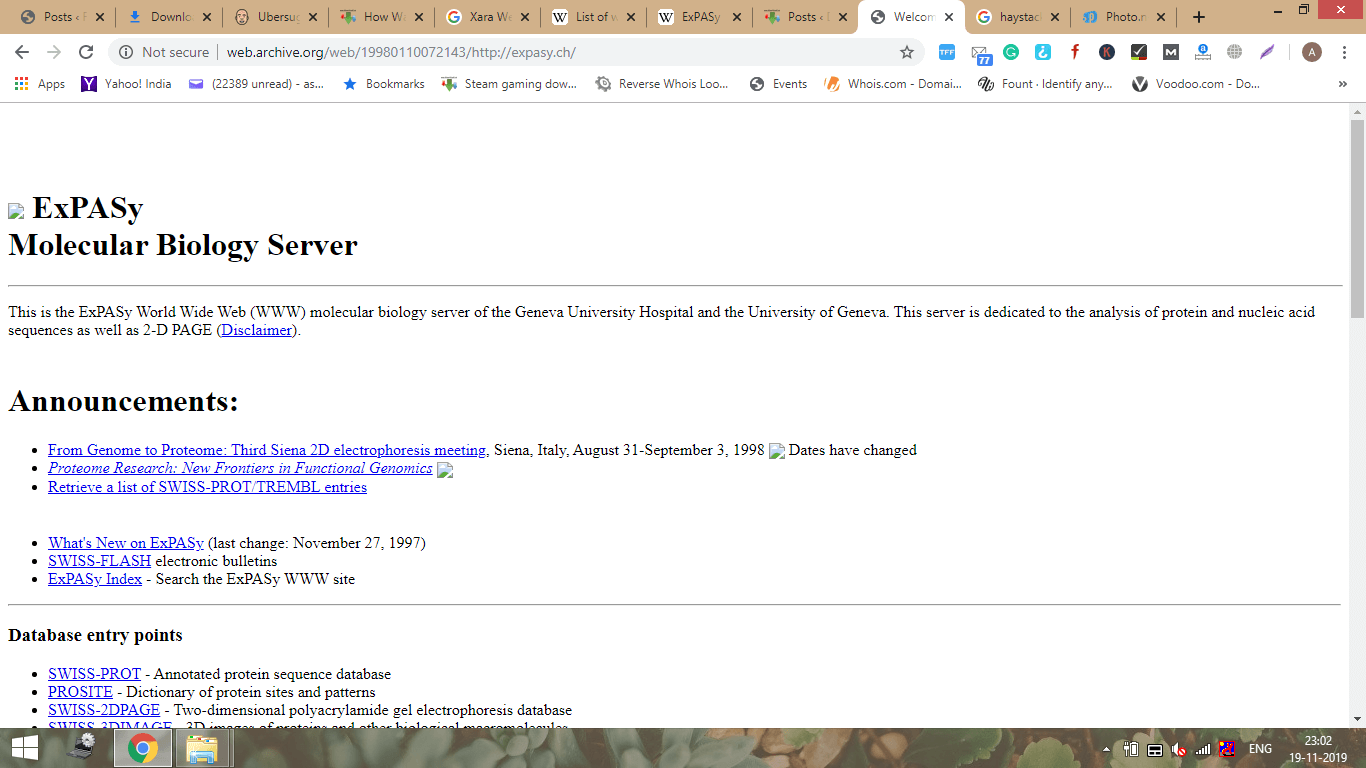
ExPASy is a bioinformatics resource portal operated by the SIB Swiss Institute of Bioinformatics and in particular the SIB Web Team. It is an extensible and integrative portal accessing many scientific resources, databases and software tools in different areas of life sciences.
ExPASy was the first website of the life sciences made public on 1st August 1993.
Current status: Live under this URL https://www.expasy.org/
32. Trojan room coffee pot – 1993 (England)
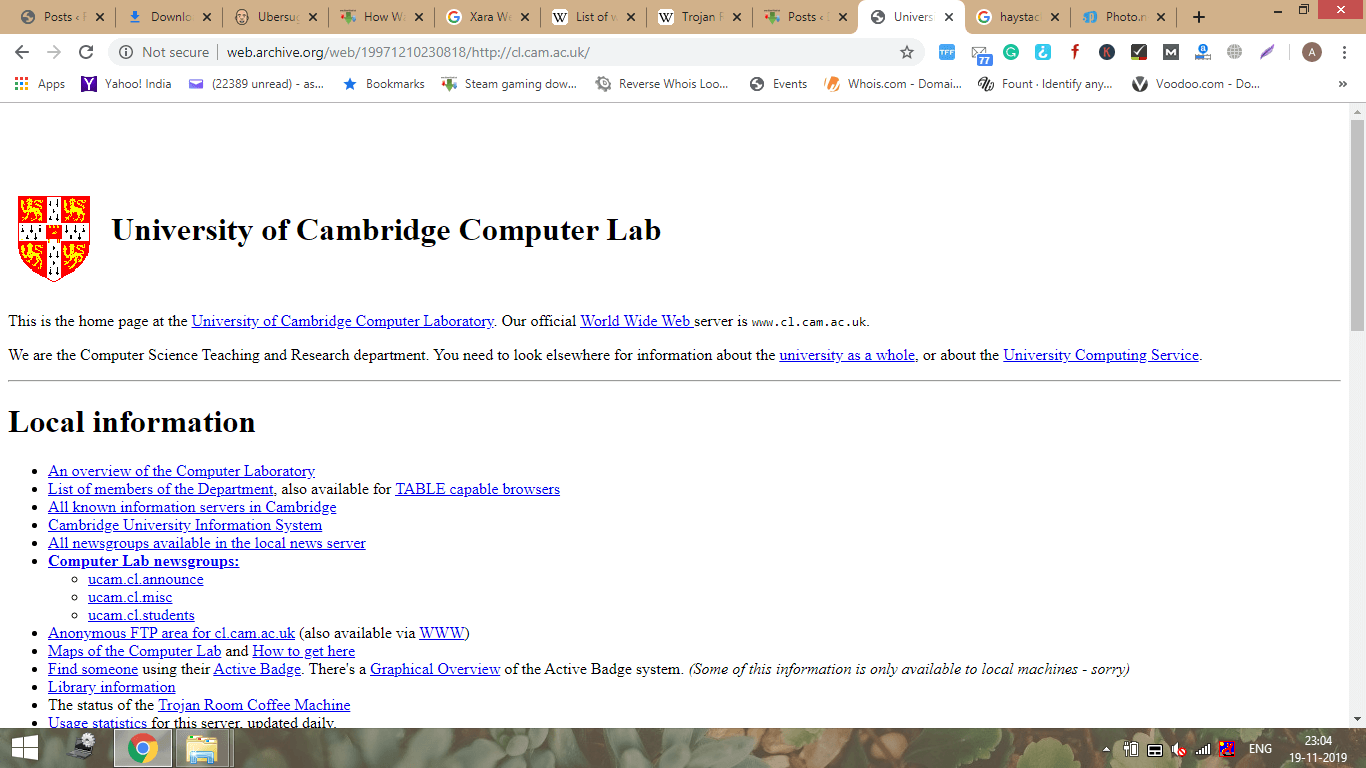
The Trojan Room coffee pot was a coffee machine located next to the so-called Trojan Room in the old Computer Laboratory of the University of Cambridge, England, which in 1991 provided the inspiration for the world’s first webcam.
To save people working in building the disappointment of finding the coffee machine empty after making the trip to the room, a camera was set up providing a live picture of the coffee pot to all desktop computers on the office network. After the camera was connected to the Internet a few years later, the coffee pot gained international notoriety as a feature of the fledgling World Wide Web, until it was retired in 2001.
Current status: defunct
33. Trincoll Journal – 1993 (USA)
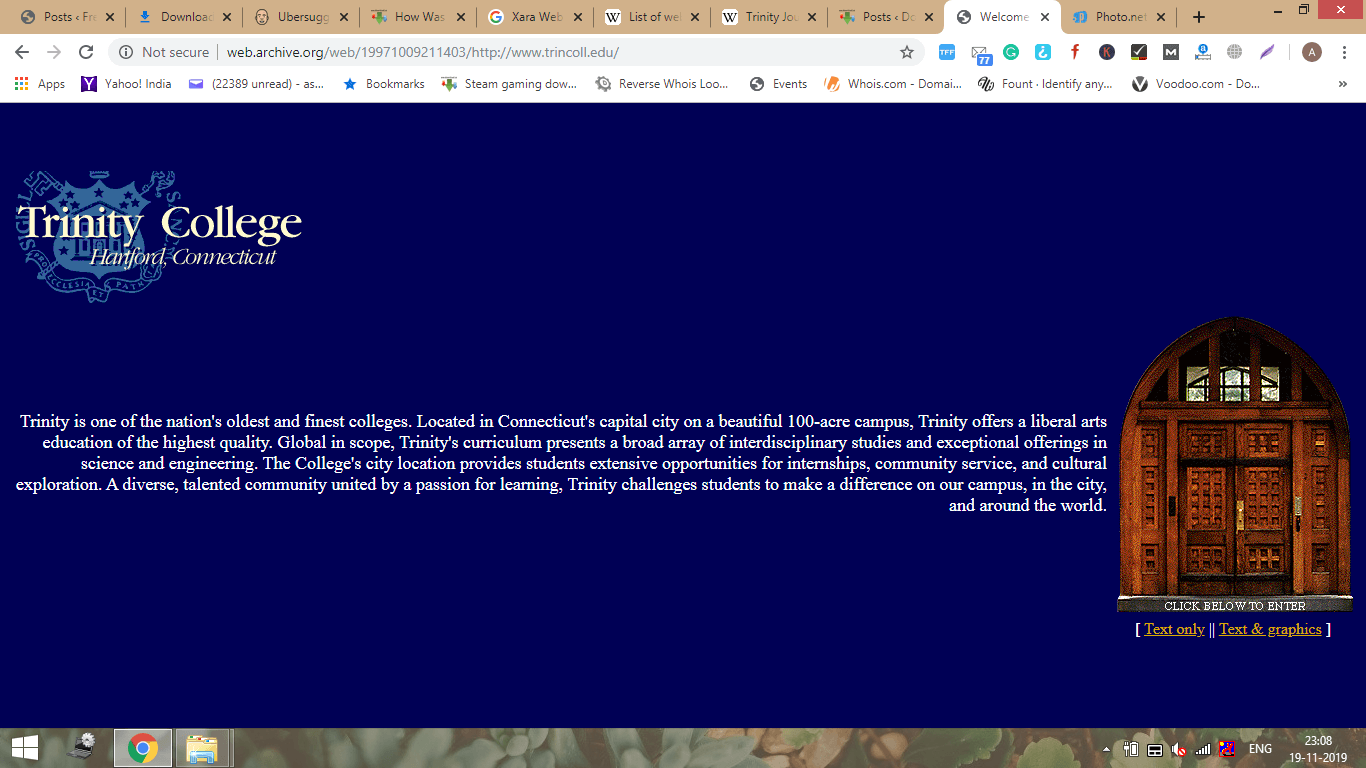
A multimedia magazine published by students at Trinity College in Hartford Connecticut. The Trincoll Journal (Trincoll Journal) is a WebZine. It was produced by a student group at Trinity College in Hartford, Connecticut, United States from 1992 until it became defunct in the spring of 2000. Most of its content is still available via the Trinity College website.
Widely cited as one of the first web-based magazines, the Trincoll Journal began published on the web in November 1993. Prior to 1993 the Journal was published in Hypercard format and distributed via FTP archives.
Current status: defunct
34. Wired.com – 1994 (USA)
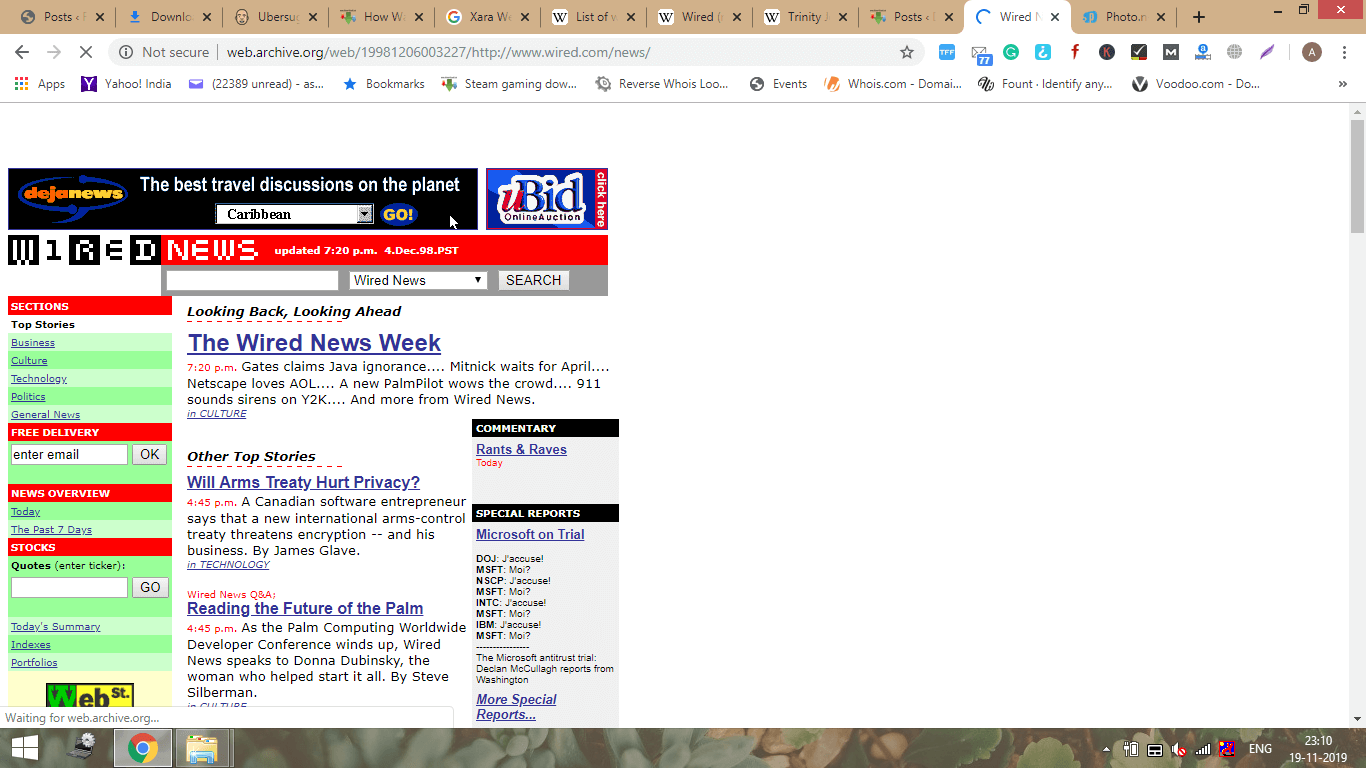
The Wired.com website, formerly known as Wired News and HotWired, launched in October 1994. The website and magazine were split in the late 1990s, when the latter was purchased by Condé Nast Publishing, Wired News (the website) was bought by Lycos not long after. The two remained independent until Condé Nast purchased Wired News on July 11, 2006, largely in response to declining profits. This move finally reunited the print and digital editions of Wired and both are currently (as of 2019) closely linked editorially.
As of February 2018, Wired.com is paywalled. Users may only access up to 4 articles per-month without payment.
Today, Wired.com hosts several technology blogs on topics in transportation, security, business, new products, video games, the “GeekDad” blog on toys, creating websites, cameras, culture, and science. It also publishes the Vaporware Awards
Current status: Live under this URL www.wired.com
Some Interesting Facts:
First Domain Name Registered
The first domain name ever registered was Symbolics.com on March 15, 1985. Now it serves as a historic site.
The First Picture Ever Uploaded
The first picture ever uploaded on the web was posted by Tim Berners-Lee (inventor of the World Wide Web) on behalf of a comedy band called Les Horrible Cernettes.
The Instant Message Sent
The first AOL Instant Message was sent by Ted Leonsis to his wife on Jan. 6, 1993. It read, “Don’t be scared … it is me. Love you and miss you.”
First Email Sent on Network
Ray Tomlinson is generally credited as having sent the first email across a network, initiating the use of the “@” sign to separate the names of the user and the user’s machine in 1971, when he sent a message from one Digital Equipment Corporation DEC-10 computer to another DEC-10. The text of that first electronic missive consisted of “something like QWERTYUIOP.”
First Website Selling Books Online
Book Stacks Unlimited, an online marketplace for selling books, launches. Initially, it launched on BBS, then moved to the internet in 1994, in the form of www.books.com
First Online Transaction ever
The first online transaction was, by some reports, marijuana sold by Stanford students to MIT students via the Arpanet account at their artificial intelligence lab in 1972. However, the first online shopping transaction on the Internet took place some 22 years later. With the headline “The Internet is Open”, the August 11, 1994, issue of New York Times chronicled the sale between two friends of a Sting CD. The Times said, “The team of young cyberspace entrepreneurs celebrated what was apparently the first retail transaction on the Internet using a readily available version of powerful data encryption software designed to guarantee privacy.”
However, officially The first item sold on eBay (back then it was AuctionWeb) was a broken laser pointer for $14.83 in 1995. The man who bought it told founder Pierre Omidyar he collected broken laser pointers and the buyer was Canadian Mark Fraser purchased the first item.
The first book purchased on Amazon was Douglas Hofstadter’s Fluid Concepts and Creative Analogies: Computer Models of the Fundamental Mechanisms of Thought in 1995.
The First Sentence Spoken on Skype
The first sentence uttered on Skype was in Estonian in April 2003 by a member of the development team. It was ‘Tere, kas sa kuuled mind?’ or “Hello, can you hear me?” in English.
The First Person On Facebook
The first non-founder to join Facebook was Arie Hasit, who is now in Israel studying to be a rabbi.
The First Youtube Video
The first YouTube video posted was posted by co-founder Jawed Karim at the San Diego Zoo. It was uploaded on April 23, 2005 and has been watched nearly 10 million times.
First Twitter Message
On 21 March 2006, Jack Dorsey shared the first tweet ever – a simple: “just setting up my twttr”. The Twitter CEO’s tweet, which was then copied verbatim by other early adopters of the social media platform, has since been liked more than 96,000 times.
First Online Dating Site
Launched in 1995, Match.com Became the First Dating Site, Match the company was founded in 1993 by entrepreneurs Gary Kremen and Peng T. Ong, and the site was launched two years later as the first official dating site.
One million babies have been born from people who met on Match.com.
The First Computer Game
The first computer game is generally assumed to be the game Spacewar!, developed in 1962 at MIT (Stephen Russell a.o.). Spacewar originally ran on a PDP-1 computer the size of a large car. By today’s standards, the graphics are rather primitive, although less primitive than many games form the 1980’s.
Very interesting topic to read about video gaming
The First Cyber Crime
1981 – Ian Murphy, known as Captain Zap to his fans, was the first person convicted of a cybercrime. He hacked into the AT&T network and changed the internal clock to charge off-hours rates at peak times.
The First Computer Virus
The first computer virus, called “Creeper system”, was an experimental self-replicating virus released in 1971. It was filling up the hard drive until a computer could not operate any further. This virus was created by BBN technologies in the US. The first computer virus for MS-DOS was “Brain” and was released in 1986.
The First Antivirus Software
The Creeper virus was eventually deleted by a program known as The Reaper. You may consider The Reaper the first antivirus software, but the word “virus” wasn’t used as the official name of a computer invasion of this type until it was coined by American computer scientist Frederick B. Cohen in 1983.
The Most Viewed Youtube Video
“Gangnam Style” by Psy is the most-viewed YouTube video of all time. It’s been viewed over two billion times.
Information Source(s)
Wikipedia
Wayback (archive.org)
Livescience.com
The Internet Live Stats
ad


Comments are closed.